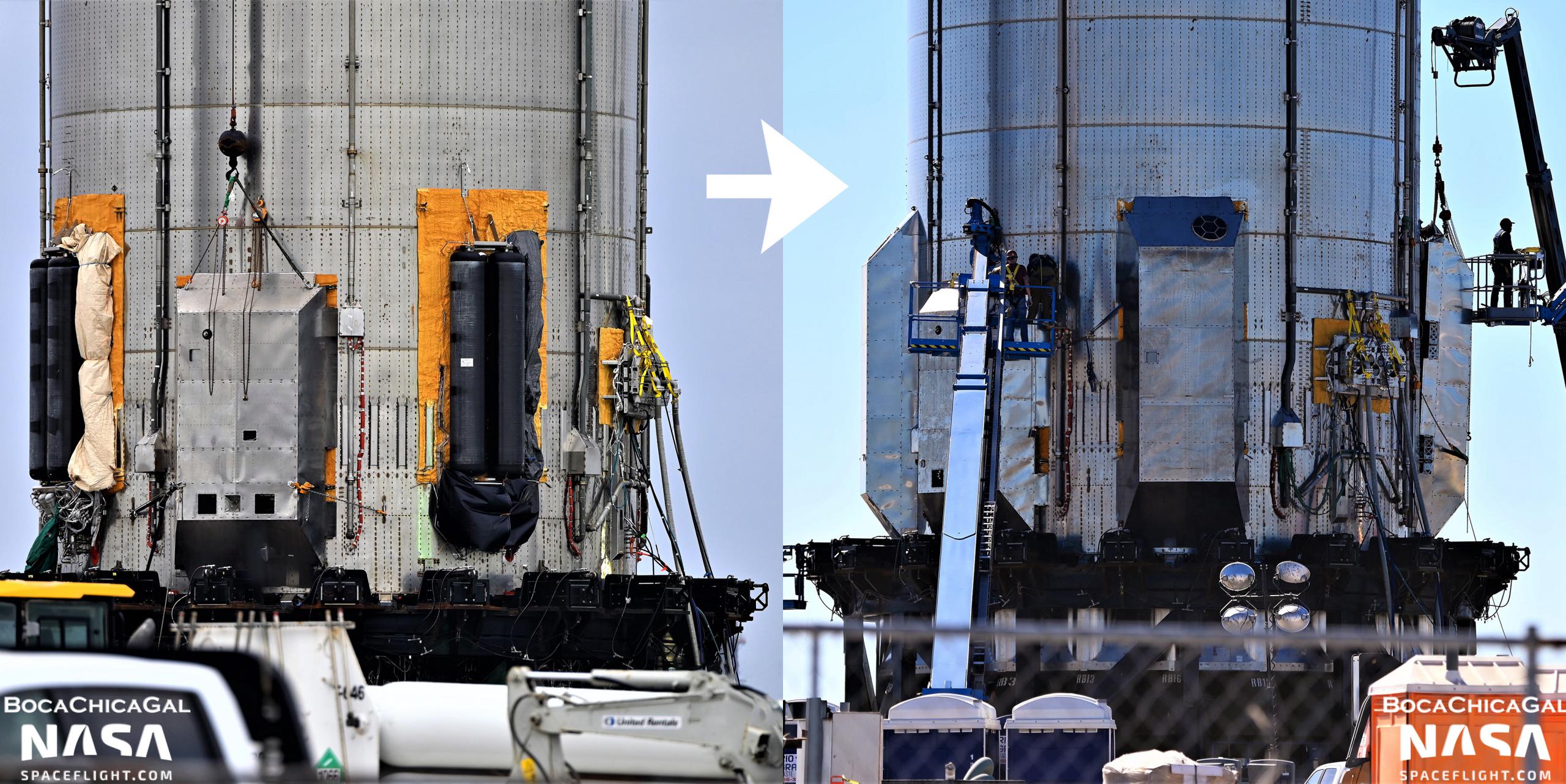
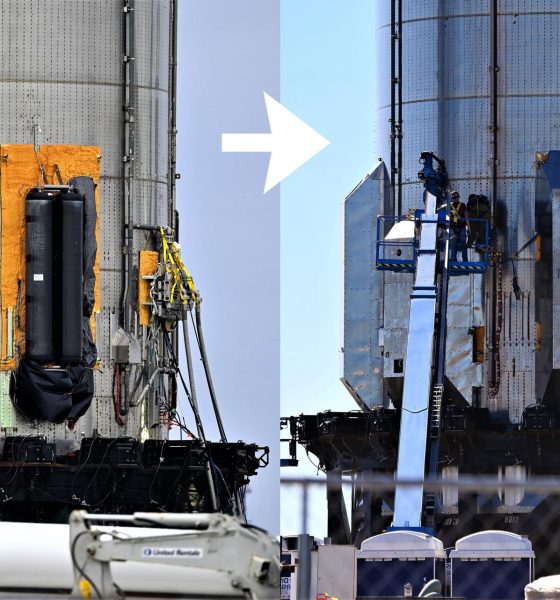
SpaceX
SpaceX fully installs Super Heavy booster’s ‘aerocovers’
For the first time, SpaceX has more or less installed a full set of ‘aerocovers’ on a Super Heavy booster prototype.
Designed to protect the booster from both itself and Earth’s atmosphere during ground testing, liftoff, ascent, and reentry, Super Heavy’s the structures amount to thin, steel shells mounted on metal box frames. The most obvious aerocovers slot over the top of six racks of equipment installed on the outside of Super Heavy’s aft end, giving the booster a sort of utility belt of hydraulic systems, pressure vessels, avionics, and heat exchangers. Unsurprisingly, those racks are festooned with electronics, composites, and thousands of feet of wiring and thin plumbing – none of which are particularly suited to sit a few dozen feet from the fury of 29-33 Raptor engines or near the leading edge of a hypersonic reentry vehicle.
Aside from the steel they’re mounted on, it’s likely that every system located on Super Heavy’s ‘utility built’ would begin malfunctioning or be destroyed outright if directly exposed to just a few seconds of the hypersonic buffeting and heating Starship boosters will experience during reentry. Unlike Falcon boosters, which almost always use reentry burns to slow down and create a sort of heat shield with their own exhaust, SpaceX is theoretically designing Super Heavy to survive the full force of reentry without an extra burn to cushion the blow.
To survive reentry and still land in good enough condition to enable anything close to same-day reusability, which is SpaceX’s goal, every ounce of at-risk equipment installed on Super Heavy’s exterior will likely need to be carefully shielded. In theory, that’s the purpose of the aerocovers SpaceX has only just begun to fully install – let alone test – on Super Heavy B4.
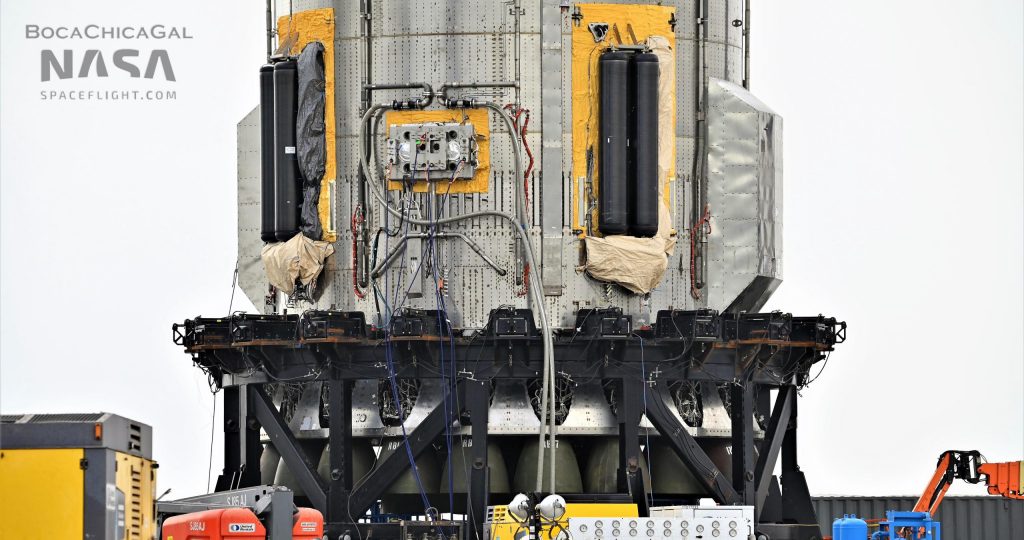
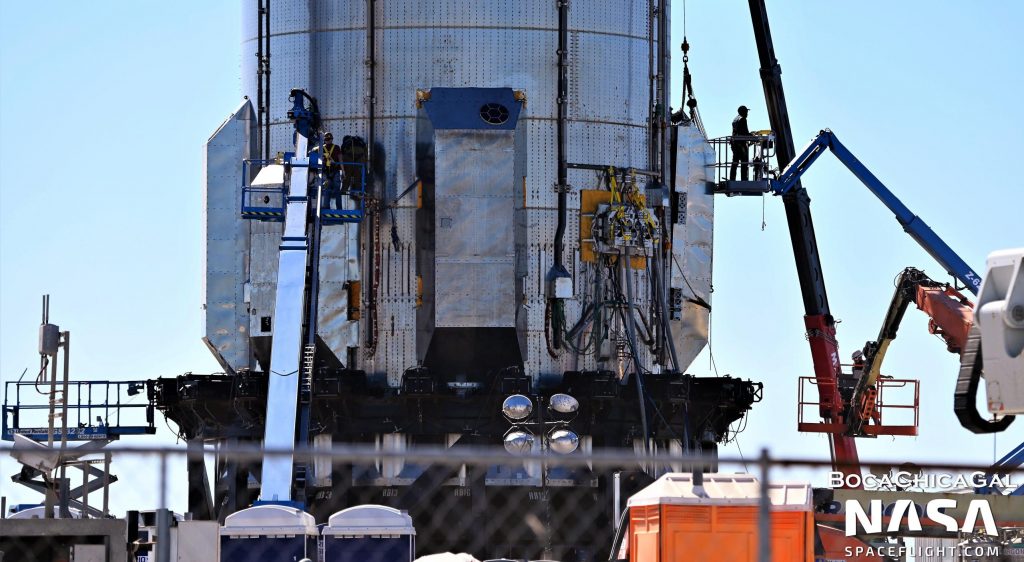
Before Booster 4’s most recent installation on the orbital launch mount, SpaceX did install covers over a pair of hydraulic and heat exchanger racks but left all four composite overwrapped pressure vessel (COPV) racks and an umbilical port uncovered. After B4 was removed from the launch mount for the third time on December 30th, both covers were uninstalled. On January 14th, 2022, though, SpaceX rapidly installed all six covers for the first time and began sealing each cover’s exposed corners. On January 17th, SpaceX even installed aerodynamic surfaces around Booster 4’s protruding umbilical port, smoothing out any hypothetical airflow around the device.
Prior to main aerocover installation, SpaceX also added at least half a dozen small boxes seemingly designed to protect a number of thin metal probes that pierce through Super Heavy’s tanks and skin and are connected to avionics boxes. Additionally, while less visible, teams also worked to finish Super Heavy B4’s Raptor heat shielding with a large number of similar sheet steel covers and panels. Without official photos from SpaceX or another lift onto the launch mount, it’s impossible to know if Booster 4’s Raptor heat shield is fully closed out, but the shielding that runs around its circumference appears to be finished.
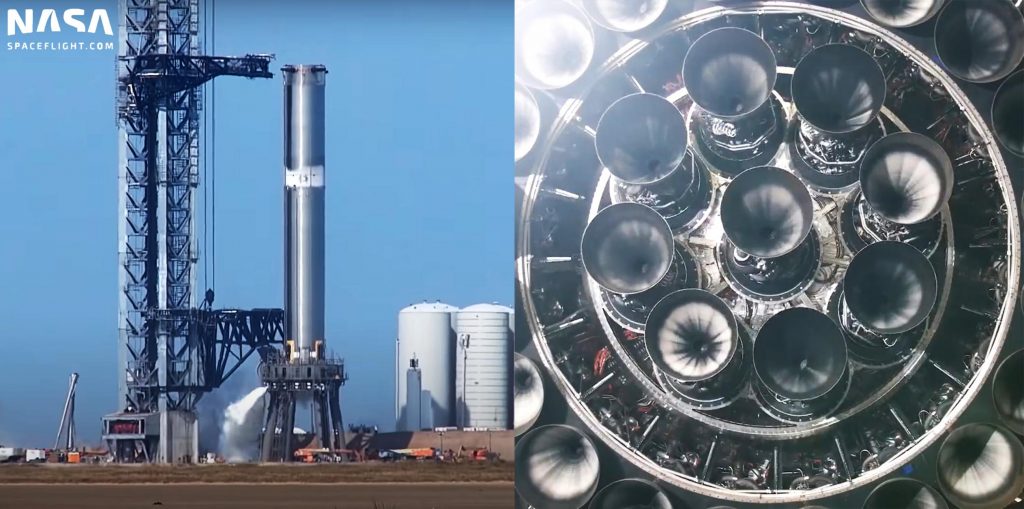
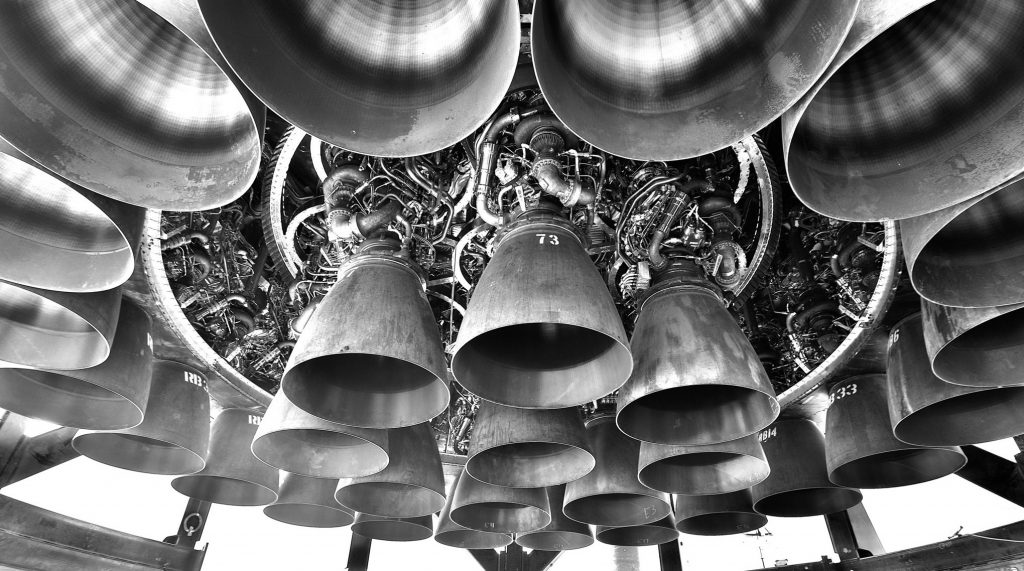
As it stands, Super Heavy B4 is likely just a few parts shy of true completion and is about as ready as it’ll ever be for static fire testing. More likely than not, those aerocovers and Raptor heat shields are essential for Super Heavy B4 to be able to perform more than one test at a time without immediately requiring major repairs. Unlike Starship, which has mostly tested three engines at once and only performed a few six-engine static fires, Super Heavy B4 may eventually test all 29 Raptor engines simultaneously.
When almost 30 engines are involved, even nominal preburner testing will likely produce a massive fireball that could engulf Super Heavy’s aft (if not the entire booster) with flames. For static fire testing, Raptors typically produce a smaller and briefer (but still substantial) fireball during shutdown, creating another potential source of damage to any sensitive hardware located anywhere on or in Booster 4’s thrust section. As such, Super Heavy aerocovers may be just as important for surviving static fires as they’ll be for surviving launches and landings.
It’s unclear if or when Super Heavy B4 will return to the orbital launch mount for wet dress rehearsal and static fire testing. SpaceX has ambiguous test windows scheduled from 10am to 10pm on January 18th, 19th, and 20th.

News
SpaceX shades airline for seeking contract with Amazon’s Starlink rival

SpaceX employees, including its CEO Elon Musk, shaded American Airlines on social media this past weekend due to the company’s reported talks with Amazon’s Starlink rival, Leo.
Starlink has been adopted by several airlines, including United Airlines, Qatar Airways, Hawaiian Airlines, WestJet, Air France, airBaltic, and others. It has gained notoriety as an extremely solid, dependable, and reliable option for airline travel, as traditional options frequently cause users to lose connection to the internet.
Many airlines have made the switch, while others continue to mull the options available to them. American Airlines is one of them.
A report from Bloomberg indicates the airline is thinking of going with a Starlink rival owned by Amazon, called Leo. It was previously referred to as Project Kuiper.
American CEO Robert Isom said (via Bloomberg):
“While there’s Starlink, there are other low-Earth-orbit satellite opportunities that we can look at. We’re making sure that American is going to have what our customers need.”
Isom also said American has been in touch with Amazon about installing Leo on its aircraft, but he would not reveal the status of any discussions with the company.
The report caught the attention of Michael Nicolls, the Vice President of Starlink Engineering at SpaceX, who said:
“Only fly on airlines with good connectivity… and only one source of good connectivity at the moment…”
CEO Elon Musk replied to Nicolls by stating that American Airlines risks losing “a lot of customers if their connectivity solution fails.”
American Airlines will lose a lot of customers if their connectivity solution fails
— Elon Musk (@elonmusk) December 14, 2025
There are over 8,000 Starlink satellites in orbit currently, offering internet coverage in over 150 countries and territories globally. SpaceX expands its array of satellites nearly every week with launches from California and Florida, aiming to offer internet access to everyone across the globe.
Currently, the company is focusing on expanding into new markets, such as Africa and Asia.
News
Tesla hints at Starlink integration with recent patent
“By employing polymer blends, some examples enable RF transmission from all the modules to satellites and other communication devices both inside and outside the vehicle.”

Tesla hinted at a potential Starlink internet terminal integration within its vehicles in a recent patent, which describes a vehicle roof assembly with integrated radio frequency (RF) transparency.
The patent, which is Pub. No U.S. 2025/0368267 describes a new vehicle roof that is made of RF-transparent polymer materials, allowing and “facilitating clear communication with external devices and satellites.”
Tesla believes that a new vehicle roof design, comprised of different materials than the standard metallic or glass elements used in cars today, would allow the company to integrate modern vehicular technologies, “particularly those requiring radio frequency transmission and reception.
Tesla has recently filed a US patent application on integrating RF transparent materials into the roof structure.
“facilitating clear communication with external devices and satellites”
Tesla fleet is getting @Starlink connectivity integration soon. LFG @Tesla @elonmusk… pic.twitter.com/bLa8YtPLd1
— Chansoo Byeon (@Chansoo) December 9, 2025
Instead of glass or metallic materials, Tesla says vehicles may benefit from high-strength polymer blends, such as Polycarbonate, Acrylonitrile Butadiene Styrene, or Acrylonitrile Styrene Acrylate.
These materials still provide ideal strength metrics for crashworthiness, stiffness for noise, vibration, and harshness control, and are compliant with head impact regulations.
They would also enable better performance with modern technologies, like internet terminals, which need an uninterrupted signal to satellites for maximum reception. Tesla writes in the patent:
“By employing polymer blends, some examples enable RF transmission from all the modules to satellites and other communication devices both inside and outside the vehicle.”

One of the challenges Tesla seems to be aware of with this type of roof design is the fact that it will still have to enable safety and keep that at the forefront of the design. As you can see in the illustration above, Tesla plans to use four layers to increase safety and rigidity, while also combating noise and vibration.
It notes in the patent that disclosed examples still meet the safety requirements outlined in the Federal Motor Vehicle Safety Standards (FMVSS).
Starlink integrated directly into Tesla vehicles would be a considerable advantage for owners. It would come with a handful of distinct advantages.
Initially, the inclusion of Starlink would completely eliminate cellular dead zones, something that is an issue, especially in rural areas. Starlink would provide connectivity in these remote regions and would ensure uninterrupted service during road trips and off-grid adventures.
It could also be a critical addition for Robotaxi, as it is crucial to have solid and reliable connectivity for remote monitoring and fleet management.
Starlink’s growing constellation, thanks to SpaceX’s routine and frequent launch schedule, will provide secure, stable, and reliable internet connectivity for Tesla vehicles.
Although many owners have already mounted Starlink Mini dishes under their glass roofs for a similar experience, it may be integrated directly into Teslas in the coming years, either as an upgrade or a standard feature.
Investor's Corner
SpaceX IPO is coming, CEO Elon Musk confirms
However, it appears Musk is ready for SpaceX to go public, as Ars Technica Senior Space Editor Eric Berger wrote an op-ed that indicated he thought SpaceX would go public soon. Musk replied, basically confirming it.

Elon Musk confirmed through a post on X that a SpaceX initial public offering (IPO) is on the way after hinting at it several times earlier this year.
It also comes one day after Bloomberg reported that SpaceX was aiming for a valuation of $1.5 trillion, adding that it wanted to raise $30 billion.
Musk has been transparent for most of the year that he wanted to try to figure out a way to get Tesla shareholders to invest in SpaceX, giving them access to the stock.
He has also recognized the issues of having a public stock, like litigation exposure, quarterly reporting pressures, and other inconveniences.
However, it appears Musk is ready for SpaceX to go public, as Ars Technica Senior Space Editor Eric Berger wrote an op-ed that indicated he thought SpaceX would go public soon.
Musk replied, basically confirming it:
As usual, Eric is accurate
— Elon Musk (@elonmusk) December 10, 2025
Berger believes the IPO would help support the need for $30 billion or more in capital needed to fund AI integration projects, such as space-based data centers and lunar satellite factories. Musk confirmed recently that SpaceX “will be doing” data centers in orbit.
AI appears to be a “key part” of SpaceX getting to Musk, Berger also wrote. When writing about whether or not Optimus is a viable project and product for the company, he says that none of that matters. Musk thinks it is, and that’s all that matters.
It seems like Musk has certainly mulled something this big for a very long time, and the idea of taking SpaceX public is not just likely; it is necessary for the company to get to Mars.
The details of when SpaceX will finally hit that public status are not known. Many of the reports that came out over the past few days indicate it would happen in 2026, so sooner rather than later.
But there are a lot of things on Musk’s plate early next year, especially with Cybercab production, the potential launch of Unsupervised Full Self-Driving, and the Roadster unveiling, all planned for Q1.








